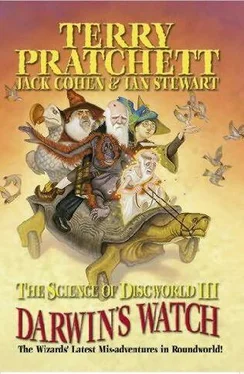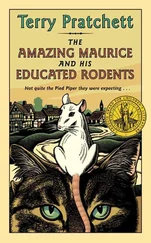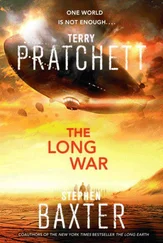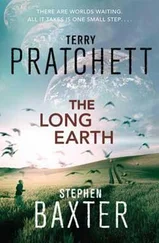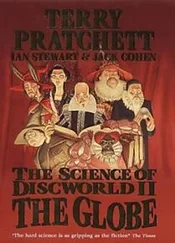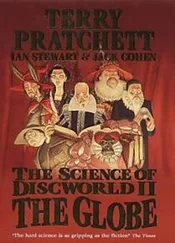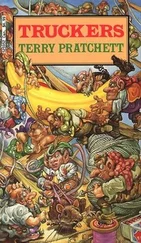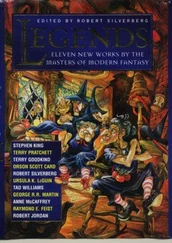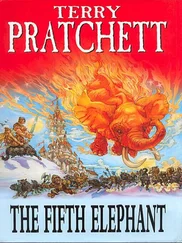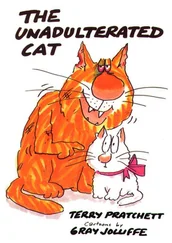Terry Pratchett - The Science of Discworld III - Darwin's Watch
Здесь есть возможность читать онлайн «Terry Pratchett - The Science of Discworld III - Darwin's Watch» весь текст электронной книги совершенно бесплатно (целиком полную версию без сокращений). В некоторых случаях можно слушать аудио, скачать через торрент в формате fb2 и присутствует краткое содержание. Жанр: Фантастика и фэнтези, на английском языке. Описание произведения, (предисловие) а так же отзывы посетителей доступны на портале библиотеки ЛибКат.
- Название:The Science of Discworld III - Darwin's Watch
- Автор:
- Жанр:
- Год:неизвестен
- ISBN:нет данных
- Рейтинг книги:3 / 5. Голосов: 1
-
Избранное:Добавить в избранное
- Отзывы:
-
Ваша оценка:
- 60
- 1
- 2
- 3
- 4
- 5
The Science of Discworld III - Darwin's Watch: краткое содержание, описание и аннотация
Предлагаем к чтению аннотацию, описание, краткое содержание или предисловие (зависит от того, что написал сам автор книги «The Science of Discworld III - Darwin's Watch»). Если вы не нашли необходимую информацию о книге — напишите в комментариях, мы постараемся отыскать её.
The Science of Discworld III - Darwin's Watch — читать онлайн бесплатно полную книгу (весь текст) целиком
Ниже представлен текст книги, разбитый по страницам. Система сохранения места последней прочитанной страницы, позволяет с удобством читать онлайн бесплатно книгу «The Science of Discworld III - Darwin's Watch», без необходимости каждый раз заново искать на чём Вы остановились. Поставьте закладку, и сможете в любой момент перейти на страницу, на которой закончили чтение.
Интервал:
Закладка:
These later species were fishes, and one of them came out on land, growing legs and lungs to do so. From these first amphibians arose the reptiles, especially the dinosaurs (while the unadventurous fishes were presumably just messing about in the sea for millions of years, waiting to be fish and chips). There were some small, obscure mammals, who survived by coming out at night and eating dinosaur eggs. When the dinosaurs died, the mammals took over the planet, and some evolved into monkeys, then apes, then Stone Age people.
Then evolution stopped, with amoebas in ponds content to remain amoebas and not wanting to be fishes, fishes not wanting to be dinosaurs but just living their little fishy lives, the dinosaurs wiped out by a meteorite. The monkeys and apes, having seen what it was like to be at the peak of evolution, are now just slowly dying out - except in zoos, where they are kept to show us what our progenitors used to be like. Humans now occupy the top branch of the tree of life: since we are perfect, there's nowhere for evolution to go any more, which is why it has stopped.
If pressed for more detail, we dredge up various things we've learned, mostly from newspapers, about things called genes. Genes are made from a molecule called DNA, which takes the form of a double helix and contains a kind of code. The code specifies how to make that kind of organism, so human DNA contains the information needed to make a human, whereas cat DNA contains the information for a cat, and so on. Because the DNA helix is double, it can be split apart, and the separate parts can easily be copied, which is how living creatures reproduce. DNA is the molecule of life, and without it, life would not exist. Mutations are mistakes in the DNA copying process - typos in the messages of life.
Your genes specify everything about you - whether you'll be homosexual or heterosexual, what kinds of diseases you will be susceptible to, how long you will live ... even what make of car you will prefer. Now that science has sequenced the human genome, the DNA sequence for a person, we know all of the information required to make a human, so we know everything there is to know about how human beings work.
Some of us will be able to add that most DNA isn't in the form of genes, but is just `junk' left over from some distant part of our evolutionary history. The junk gets a free ride on the reproductive roller-coaster, and it survives because it is `selfish' and doesn't care what happens to anything except itself.
Here ends the folk view of evolution. We've parodied it a little, but not by as much as you might hope. The first part is a lie-to-children about natural selection; the second part is uncomfortably close to `neo-Darwinism', which for most of the past 50 years has been the accepted intellectual heir to The Origin. Darwin told us what happens in evolution; neo-Darwinism tells us how it happens, and how it happens is DNA.
There's no question that DNA is central to life on Earth. But virtually every month, new discoveries are being made that profoundly change our view of evolution, genetics, and the growth and diversification of living creatures. This is a vast topic, and the best we can do here is to show you a few significant discoveries and explain why they are significant.
Just as physics replaced Newton by Einstein, there has been a major revolution in the basic tenets of biology, so we now have a different, more universal view of what drives evolution. The `folk' evolutionary viewpoint: `I've got this new mutation. I have become a new kind of creature. Is it going to do me any good?' is not the way modern biologists think.
There are many things wrong with our folk-evolution story. In fact we've deliberately constructed it so that every single detail is wrong. However, it's not very different from many accounts in popular science books and television programmes. It assumes that primitive animals alive today are our ancestors, when they are our cousins. It assumes that we `came from' apes, when of course the ape-like ancestor of man is the same creature as the man-like ancestor of modem apes. More seriously, it assumes that mutations in the genetic material, the changes that natural selection has to work on - indeed, to select among - are checked out as soon as they appear, and labelled `bad' (the organism dies, or at least fails to breed) or `good' (the animal contributes its progeny to the future).
Until the early 1960s, that was what most biologists thought too. Indeed, two very famous biologists, J.B.S. Haldane and Sir Ronald Fisher, produced important papers in the mid-1950s espousing just that view. In a population of about 1000 organisms, they believed, only about a third of the breeding population could be `lost' to bad gene variants, or could be ousted by organisms carrying better versions, without the population moving towards extinction. They calculated that only about ten genes could have variants (known as `alleles') that were increasing or decreasing as proportions of the population. Perhaps twenty genes might be changing in this way if they were not very different in `fitness' from the regular alleles. This picture of the population implied that almost all organisms in a given species must have pretty much the same genetic make-up, except for a few which carried the good alleles coming in, and winning, or the bad alleles on the way out [48] They made exceptions for manifestly `unimportant' but very diverse sets of alleles like blood groups, but in those cases it didn't seem to matter much which kind you had.
. These exceptions were mutants, famously and stupidly portrayed in many SF films.
However, in the early 1960s Richard Lewontin's group exploited a new way to investigate the genetics of wild (or indeed any) organisms. They looked at how many versions of common proteins they could find in the blood, or in cell extracts. If there was just one version, the organism had received the same allele from both of its parents: the technical term here is `homozygous'. If there were two versions, it had received different ones from each parent, and so was `heterozygous'.
What they found was totally incompatible with the Fisher-Haldane picture.
They found, and this has been amply confirmed in thousands of wild populations since, that in most organisms, about ten percent of genes are heterozygous. We now know, thanks to the Human Genome Project, that human beings have about 34,000 genes. So about 3400 are heterozygous, in any individual, instead of the ten or so predicted by Haldane and Fisher.
Furthermore, if many different organisms are sampled, it turns out that about one-third of all genes have variant alleles. Some are rare, but many of them occur in more than one per cent of the population.
There is no way that this real-world picture of the genetic structure of populations can be reconciled with the classical view of population genetics. Nearly all current natural selection must be discriminating between different combinations of ancient mutations. It's not a matter of a new mutation arriving and the result being immediately subjected to selection: instead, that mutation must typically hang around, for millions of years, until eventually it ends up playing a role that makes enough of a difference for natural selection to notice, and react.
With hindsight, it is now obvious that all currently existing breeds of dog must have been 'available'- in the sense that the necessary alleles already existed, somewhere in the population - in the original domesticated wolves. There simply hasn't been time to accumulate the necessary mutations purely in modern dogs. Darwin knew about the amount of cryptic and overt variation in pigeons, too. But his successors, hot on the trail of the molecular basis of life, forgot about wolves and pigeons. They pretty much forgot about cells. DNA was complicated enough: cell biology was impossible, and as for understanding an organum ...
Читать дальшеИнтервал:
Закладка:
Похожие книги на «The Science of Discworld III - Darwin's Watch»
Представляем Вашему вниманию похожие книги на «The Science of Discworld III - Darwin's Watch» списком для выбора. Мы отобрали схожую по названию и смыслу литературу в надежде предоставить читателям больше вариантов отыскать новые, интересные, ещё непрочитанные произведения.
Обсуждение, отзывы о книге «The Science of Discworld III - Darwin's Watch» и просто собственные мнения читателей. Оставьте ваши комментарии, напишите, что Вы думаете о произведении, его смысле или главных героях. Укажите что конкретно понравилось, а что нет, и почему Вы так считаете.
